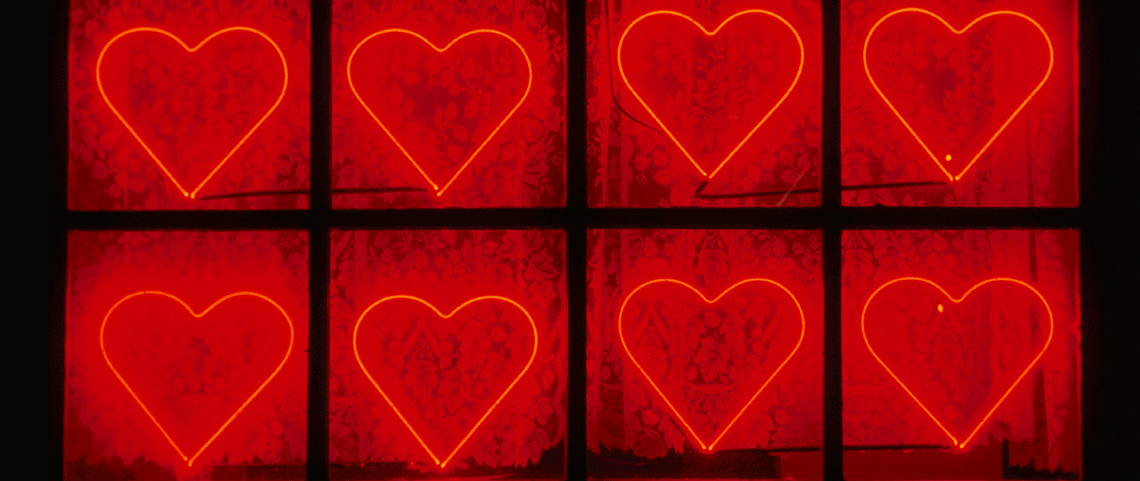
Love Is All You Need: Creative Couples in History
The creative world is filled with great love stories between artists who have inspired each other to achieve great things. Some of these stories have ended happily, some in tragedy. From John and Yoko to Frida and Diego, we take a look at some of these artistic power couples and the effect they had on each other and the world around them.
“July 13, 1954 was the most tragic day of my life. I had lost my beloved Frida forever. Too late now I realized that the most wonderful part of my life had been my love for Frida.” – Diego Rivera

Mexican painters Frida Kahlo (1907-1954) and Diego Rivera (1886-1957) in their workshop in 1948, / Bridgeman Images
Frida Kahlo (6 July 1907 – 13 July 1954) and Diego Rivera (8 December 1886 – 24 November 1957) met when she was a young art student looking for career advice and he was a famous mural painter – the meeting proved life changing for them both. Although he was already married they soon fell in love and wed in 1929, when she was aged 22 and he was 42. Despite the age difference they stayed together until Frida’s premature death in 1954. They were both passionate people and their relationship was famously tumultuous – they even divorced in 1939 only to remarry a year later, despite their fights and many infidelities their love endured. Their work also flourished as a result of their partnership – both influenced by their shared Mexican heritage and political leanings (both were members of the Communist party). Both achieved recognition and fame during their lifetimes, and are still considered two of the most important artists of the 20th century.
“I love creation more than life, and I must express myself before disappearing.” – Sonia Delaunay
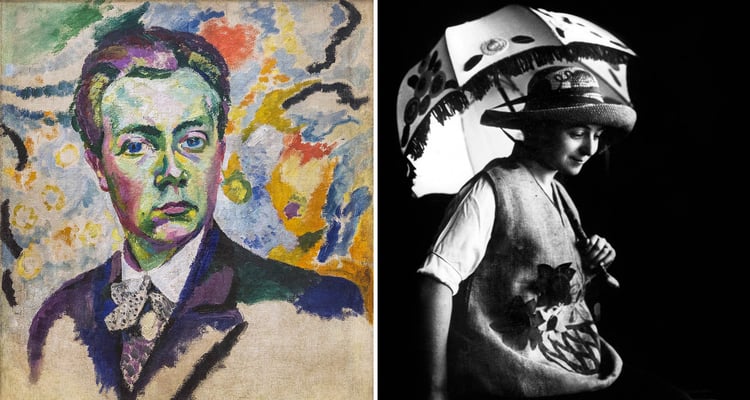
Left: Self-portrait – Robert Delaunay (1885-1941) – winter 1905-1906 – Paris, Centre Pompidou – Musee national d’art moderne / © Selva/Leemage. Right: Sonia Delaunay (1885-1979) French painter and designer / PVDE
Sonia (14 November 1885 – 5 December 1979) and Robert Delaunay (12 April 1885 – 25 October 1941) met in 1909 while working as artists in Paris. The couple were inspired by the stimulating world of La Belle Epoque, which led them to the creation of the Orphism art movement, along with other artists. An offshoot from Cubism, Orphism was characterised by faceted compositions, vibrant colour, and contemporary subject matter which together conveyed excitement in modern life and its technological innovations. Sonia’s work encompassed painting, textile design and stage set design in to which she would create beautiful abstract patterns. Her husband Roberts’ paintings were figurative to begin with but moved toward complete abstraction in an attempt to convey light and depth through colour alone. Sonia and Robert became the the main protagonists of the Orphic movement, and remained faithful to the style for the rest of their careers. They stayed together until Robert Delaunay’s death in 1941.
Lee Krasner and Jackson Pollock
“With Jackson there was quiet solitude. Just to sit and look at the landscape. An inner quietness. After dinner, to sit on the back porch and look at the light. No need for talking. For any kind of communication.” – Lee Krasner
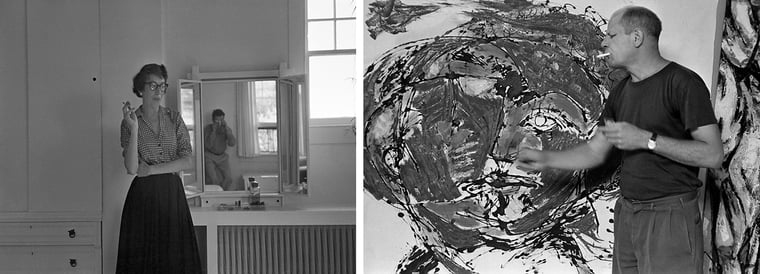
Left: Lee Krasner, 1953 (b/w photo) / Private Collection / Photo © Tony Vaccaro. Right: Jackson Pollock Painting, 1953 (b/w photo) / Private Collection / Photo © Tony Vaccaro
When Lee Krasner (27 October 1908 – 19 June 1984) and Jackson Pollock (28 January 1912 – 11 August 1956) married in 1945, Lee was already established as a prominent abstract artist in the New York avant-garde scene. Lee was key in introducing Pollock to prominent people in the art community including the art critic Clement Greenberg, who would go on to call Pollock the greatest painter the US had produced. They moved to East Hampton after World War II ended. Pollock was struggling badly with his alcoholism and they thought it would be good to get him out of the city. Pollock managed to stay sober for a few years after the move, and these years proved to be his most productive as a result. Krasner and Pollock both worked at the house, but in isolation from each other. As a result, Krasner claimed that any influence on each other’s work was unconscious. However, some art historians have speculated that Pollock’s free and spontaneous style influenced his wife, and Pollock in turn was influenced by Krasner’s more controlled and refined method of working. Unfortunately Jackson Pollock’s sobriety did not last and he died in 1956 after crashing his car into a tree near their home, whilst under the influence. After her husband’s death, Krasner threw herself into her painting. Having been in her famous husband’s shadow for many years, in 1984 she did get the recognition she deserved and was one of the few women to have a solo show at the Museum of Modern Art. This year there will be a retrospective of her work at the Barbican in London.
Georgia O’Keeffe and Alfred Stieglitz
“I’m getting to like you so tremendously that it some times scares me..” O’keeffe in letter to Stieglitz from 1916
Georgia O’Keeffe (15 November 1887 – 6 March 1986) and Alfred Stieglitz (1 January 1864 – 13 July 1946) met when he was a famous photographer in his 50s and she was an art teacher in her 20s. At the beginning their relationship was that of mentor and mentee. He was the first to exhibit her abstract drawings and helped her become the respected painter she grew in to by giving her both emotional and financial support. They eventually became romantically involved, and married in 1924. Eventually O’Keeffe moved to New Mexico and their relationship transitioned into a long distant one. The 20,000 letters they wrote to each other during this time have been since collated for the book “My Faraway One: Selected Letters of Georgia O’Keefe and Alfred Stieglitz”.
Jasper Johns and Robert Rauschenberg
“[we gave] permission to do what we wanted…. It would be hard to imagine my work at that time [around 1956 – 1960] without his [Jasper Johns] encouragement.” –
Robert Rauschenberg, 2006.
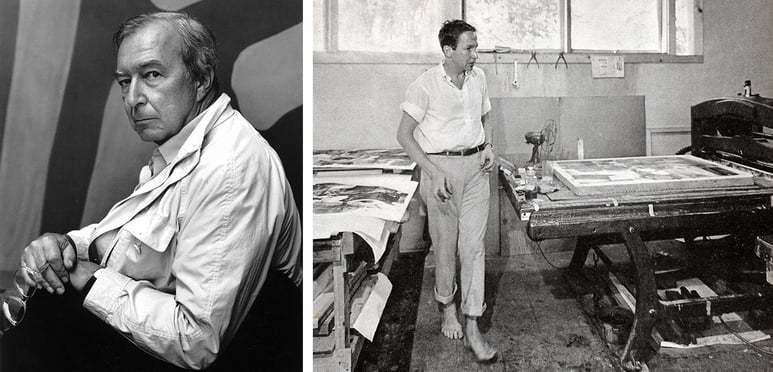
Left: Jasper Johns, Venice, Italy, 1988 (b/w photo) / © Chris Felver. Right: The painter Robert Rauschenberg in Tatyana Grosman studio, New York, USA. Photo in the artistic magazine: L̥Oeil, France, Dec., 1964.. / Photo © CCI
The relationship between Jasper Johns (born 15 May 1930) and Robert Rauschenberg (22 October 1925 – 12 May 2008) was relatively short-lived, but extremely impactful. They became a couple in 1954 and started to collaborate together as artists. Together their work moved away from Abstract Expressionism that was the prevalent style and towards something new; now known as Pop Art. They are largely credited with being the fathers of the Pop Art movement which incorporate images of objects from popular culture and elevated them in to iconic symbols. After 6 years together the relationship ended, and they did not speak to each other for years after. However, the work they produced when they were together proved to be some of their best and most influential work.
“If you are submerged in normal life, then your view will be normal. So we have to keep separate from normal life in order to be able to say something that is not known. People come to art for something that they don’t understand, that’s not in their life already.” – Gilbert and George, from The words of Gilbert & George
Gilbert Proesch (born 17 September 1943) and George Passmore (born 8 January 1942), met in 1967 while studying sculpture at Saint Martin’s College. According to them both it was love at first sight. Since 1968 they have lived on Fournier Street in Spitalfields, East London. Their entire body of work has been created in and focused on London’s East End, which they see as a microcosm. According to George, “Nothing happens in the world that doesn’t happen in the East End”. They make no distinction between their art and their life, and are rarely seen not wearing their trademark suits, or without the other.
Elizabeth Taylor & Richard Burton
“At 12 noon I did something beyond outrage. I bought Elizabeth the jet plane we flew in yesterday. It costs, brand new, $960,000. She was not displeased.” – Richard Burton from his diaries, 1968
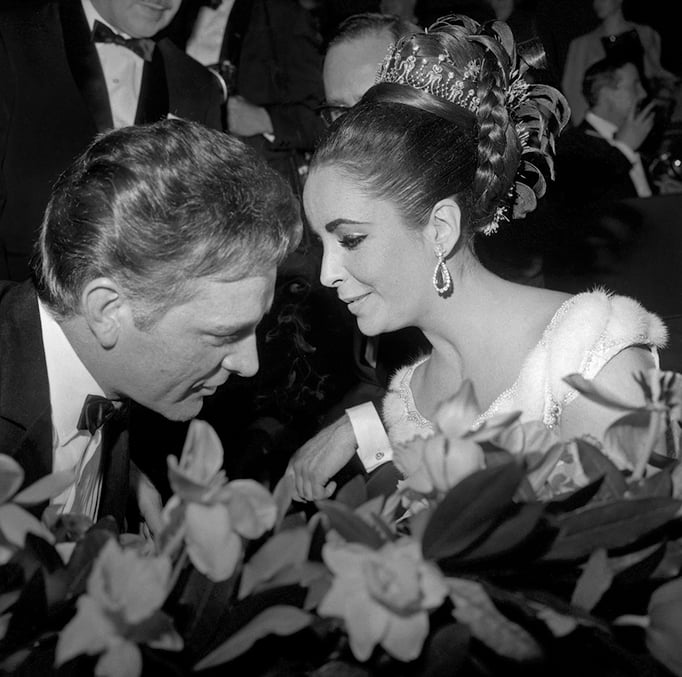
Richard Burton and Elizabeth Taylor during a party at the English Embassy in Paris after the opening night of ‘Lawrence of Arabia’, 15th March 1963 (b/w photo) / Photo © AGIP
The love affair between Elizabeth Taylor (27 February 1932 – 23 March 2011) and Richard Burton (10 November 1925 – 5 August 1984) was both glorious and infamous. Films have been made about their tumultuous and ultimately destructive relationship. Both were married when they met in 1963 on the set of Cleopatra – the most expensive film ever made at the time – when Taylor was at the height of her stardom (she became the first star in Hollywood to command a salary of one million dollars). Despite their marriages the pair fell in love, and divorced their respective partners and were married a year later on 5th March 1964. Their union was denounced by the Catholic Church as “erotic vagrancy” and they were met with widespread disapproval. However, the romance and beauty of Taylor and Burton soon won people over and they became the hottest properties in the world, on and off the screen. Unfortunately, both were alcoholics, which proved to be very destructive to their relationship. They divorced in 1974, and although they remarried 16 months later they were divorced again before a year had passed. Taylor was married 8 times in her life (including twice to Burton). Before the end of her life, Taylor was to say of her relationship with Burton: “I was a fool to marry so often. If I had my time over again, I would never do that. The truth is I now don’t give a damn about most of those men. Richard is the only one I truly loved and still care about. I shall miss him until the day I die.” (quote from Michael Thornton in The Telegraph).
“Bill was incredibly in love with her, but she didn’t treat him very well at the beginning… She would lean back on the couch and say, ‘Bill. Cigarette.’ And he would leap to get it.” Photographer Rudy Burkhardt on their early relationship
Elaine Fried (March 12, 1918 – February 1, 1989) and Willem de Kooning (24 April 1904 – 19 March 1997) met in New York in 1938. In 1926 de Kooning – an immigrant from the Netherlands – travelled to the United States as a stowaway on a British freighter bound for Argentina. Fried and de Kooning were introduced by Fried’s art teacher. After that Willem offered to give Elaine lessons in academic drawing, and they began to fall in love. It was an attraction of opposites – she was outgoing and free spirited, he was introverted, gloomy, and obsessed with work. He gave her strict lessons in traditional drawing, as he felt she lacked discipline in her work. As a result her confidence grew as a portrait painter. The couple had an open relationship, and Fried is said to have had affairs with prominent people within the art world in order to help promote her husband’s work. However, in 1957 the pair divorced, due to excessive drinking (both were alcoholics) and too many affairs. They remarried in 1976. While de Kooning’s work has achieved the greatest fame, Fried did have an impressive career which included a commission to paint the portrait of John. F. Kennedy in 1962.
“As usual, there is a great woman behind every idiot.” – John Lennon

John Lennon and his wife Yoko Ono are having a week’s love-in in their room at the Hilton Hotel, March 1969 (b/w photo); Amsterdam, The Netherlands. © Mirrorpix / Bridgeman Images
John Lennon (9 October 1940 – 8 December 1980) and Yoko Ono (born February 18, 1933) met in a gallery in London while Yoko (a visual and performing artist) was preparing for an exhibition of her work. They had a whirl-wind romance and married in March 1969. John Lennon left the Beatles a year later triggering speculation about whether Yoko was to blame for the split. Their relationship was dogged by disapproval from the public, who saw Yoko as a marriage wrecker (Lennon was already married with children when they met) as well as responsible for splitting up the Beatles. Their relationship certainly was all consuming, and they would go on to collaborate in many art and musical projects right up until the murder of Lennon in December 1980. Lennon wrote many songs dedicated to Yoko Ono, including The Ballad of John and Yoko (1969), and Oh Yoko! (1971).
June Carter Cash & Johnny Cash
“One morning, about four o’clock, I was driving my car just about as fast as I could. I thought, ‘Why am I out on the highway this time of night?’ I was miserable, and it all came to me: ‘I’m falling in love with somebody I have no right to fall in love with. I can’t fall in love with this man, but it’s just like a ring of fire.” – June Carter Cash
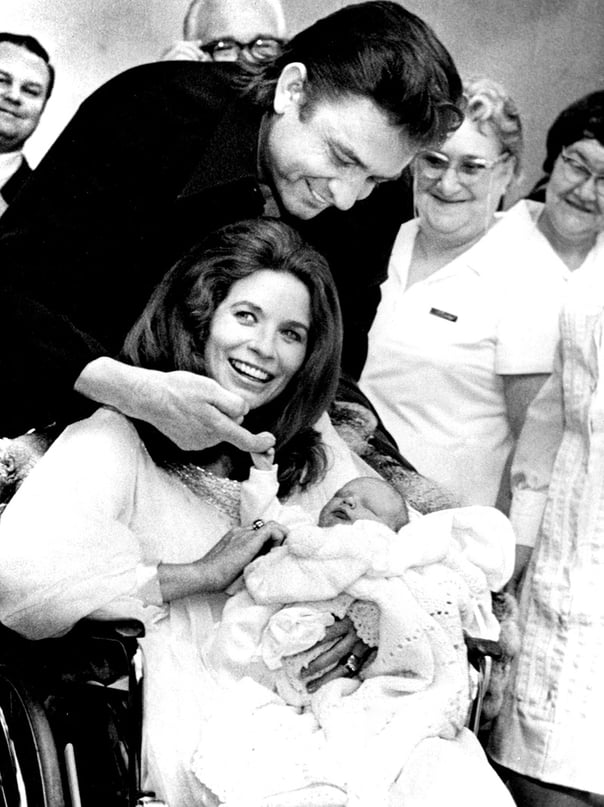
JOHNNY CASH, with wife June Carter Cash and son John Carter c. 1970 / CSU Archives/Everett Collection
Johnny Cash (26 February 1932 – 12 September 2003) and June Carter (23 June 1929 – 15 May 2003) met in 1956 backstage at the Grand Ole Opry, a weekly country music show in Nashville, Tennessee. Both had established music careers – June was a singer in the Carter Family – and both were married. Despite this, legend has it that Johnny Cash was immediately infatuated with June, and declared that he would marry her one day. This prophesy turned out to be true, although she did not accept his proposal until 1968, when he asked the big question during a live performance in front of 7,000 fans in London. After their first meeting in 1956, there paths crossed many times and their affection for each other grew. June Carter wrote “Ring of Fire” about her growing feelings for Johnny Cash and the guilt she felt about the breaking up of his first marriage (from which he had 3 children). Johnny Cash ended up recording “Ring of Fire”, and it became a huge hit, staying on top of the country charts for 7 weeks during 1963. In 1966, Cash was in the grip of severe addiction to alcohol and amphetamines. It was June’s insistence that he give up both if they were to get married, that likely saved his life. Once he had given up they got married in 1968 and gave birth to their son John Carter Cash in 1970. During their 30 year marriage they went on to record many tracks together, which have become benchmarks for the classic country duet. Hits they recorded together include “Jackson” and “Long-Legged Guitar Pickin’ Man”. June Carter died in May 2003, and a broken-hearted Johnny Cash died only 4 months later. Johnny Cash once said of the relationship with June: “There’s unconditional love there. You hear that phrase a lot but it’s real with me and her. She loves me in spite of everything, in spite of myself. She has saved my life more than once. She has certainly been there with her love, and it has certainly made me forget the pain for a long time, many times. When it gets dark and everybody’s gone home and the lights are turned off, it’s just me and her.”



